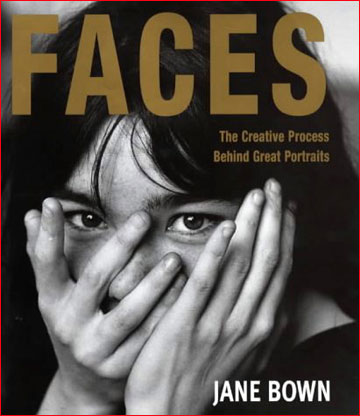Jane Bown
SMP Book of the Week:
Faces: the Creative Process Behind Great Portraits

It may come as a surprise to some readers that some very good photographers — including some great ones — don’t have much interest in photography. Rather, they are interested in what they take picturesof. Jazz musicians, sailboats, wars, abstract designs found in nature, whatever.
I can’t speak for Jane Bown’s interest or disinterest in photography, but she obviously has more affection for people and faces than she does for potions and powders and camera serial numbers and the introductory dates of obscure accessories. Although she is apparently well known (and well regarded) in Great Britain, I’d never heard of her before. Everything I know about her is contained in this book. It seems enough, however.
To begin with, unlike many books, this one delivers exactly what its title promises. It is called ‘faces,’ and the pictures are of faces. (Well, I would argue that they are also of light, but then that’s true of most great black-and-white photographers.) Its subtitle also promises to explain ‘the creative process behind great portraits,’ and this it also does.
In fact, that whole subject is crisply dispatched in the very brief introduction. This is perhaps the shortest, plainest, least pretentious, most to-the-point, and wisest little essay of any I can remember that contains such riches. Not everyone works the same way, but then, the best any one of us can do is to pinpoint precisely and with great communicative power what, why, and how we do what we do. I’ve read this essay four times now, I think (I tend to read it every time I crack open the book), and I’m sure I’ll read it again. I recommend it to everybody — not just to read, but to read carefully. (And there are some people, I have to say, that I wish I could whack over the head with it. Annie Leibovitz, for starters.)
The pictures are superb. As you learn in the introduction, Bown, for years a newspaper photographer, photographs very simply, with minimal equipment and "found" natural light, using very little film and often in very little time, sometimes dealing with other constraints as well. Her style and her vision suit each other, and most likely suit her personality and her talent very well too. A careful viewer of this book could use it in any number of ways — as glimpses of the personalities of famous people, as an example of often perfect technique, as an instruction manual about lighting. It is, for 35mm available-light portraiture, about what Ansel Adams’sExamples: The Making of Forty Pictures is for black-and-white landscapes.
______________________________________________________
A Suitable Dress
In keeping with the aesthetic of simplicity, the book itself is decently unpretentious. For years now, it has been conventional for photography books to be large coffee-table confabulations, with "bold" full-bleeds and gutter-bleeds, and various conceits of design and materials employed with varying degrees of success. By comparison, many of the books that most influenced me, from the ’60s and ’70s, are modest in size, and sometime brief. (I’m not sure why the books of so many garden-variety glamor-puss studio photographers deserve to be three times as expensive and four times as grand as, say, Walker Evans’sAmerican Photographs.) Fact is, pictures needn’t be huge in order to be seen. (A lot of gallery photographers would do well to realize this, but I guess they’re beholden to fashion.) Anyway,Facesisn’t very big and it’s of modest length. I don’t find a thing wrong with that.
The design of the book is adequately unfussy. The text is set in the sort of spidery sans-serif that’s been popular in English books lately. The postmodern page-number flags are a little distracting, but, on the other hand, gutter-bleeds are used sparingly — they only really ruin two portraits (those of Bishop Desmond Tutu and Isabella Rossellini). Its special feature is that the glossy cover boards reproduce the dust jacket, as on a children’s book, which is nice if, for instance, you were negligent and allowed your rambunctious ten-year-old to destroy the dust jacket. (Ahem.)
According to my own prejudices, and given that thesoft cover versioncosts all of fourteen bucks at Amazon.com, I’d say this book should be in your library…whether you care about either photography or faces. Most especially, it’s indispensable for those who like this style and would like to learn more about this way of working.
I have to admit that when I first got the book I wasn’t bowled over, but I’ve increasingly come to appreciate Bown’s genius. I enjoy this book more each time I turn to it.
Mike’s Curmudgeonly Rating:
* Content: A
* Reproductions: A
* Presentation: C+
* Bookcraft: B
* Synergy and intangibles: B+Recommendation: * * * *
— Mike Johnston
See Mike Johnston’s website atwww.37thframe.com. Also, check out his monthly column in the BritishBlack & White Photographymagazine! (Usually available at Barnes & Noble bookstores.)
Want to read more? Go to the SMP Archives
Please support this column by subscribing toThe 37th Frame,Mike Johnston’s print newsletter for photographers.Mike Johnstonwrites and publishes an independent quarterly ink-on-paper magazine calledThe 37th Framefor people who are really "into" photography. His book,The Empirical Photographer, has just been published.
You can read more about Mike and findadditional articlesthat he has written for this site, as well as aSunday Morning Index.
You May Also Enjoy...
VJ9 Rebel Review
Subscribe to The Video Journal Please use your browser'sBACKbutton to return to the page that brought you here.
Nomads
By: Mark Pelletier Young girl waits at the well.Canon D60, 70-200mm @ 200mm, 1/750 sec, f/5.6, ISO: 100, Flash: OffThursday, 30 January, 2003 – Khartoum,
